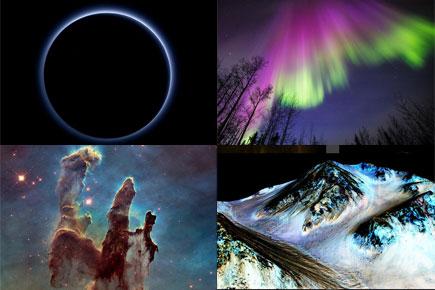World Space Week (WSW) is an annual event observed from October 4-10 in various parts of the world. On the conclusion of World Space week, we take a look at some of the stunning images of the space

World Space Week (WSW) is an annual event observed from October 4-10 in various parts of the world. The week is officially defined as an international celebration of science and technology, and their contribution to the betterment of the human condition.
On the conclusion of World Space week, we take a look at some of the stunning images of the space.
ADVERTISEMENT
Pluto's haze layer shows its blue colour in this picture taken by New Horizons Ralph/Multispectral Visible Imaging Camera (MVIC). The high-altitude haze is thought to be similar in nature to that seen at Saturn's moon Titan. The source of both hazes likely involves sunlight-initiated chemical reactions of nitrogen and methane, leading to relatively small, soot-like particles (called tholins) that grow as they settle toward the surface. This image was generated by software that combines information from blue, red and near-infrared images to replicate the colour a human eye would perceive as closely as possible.
Also Read: Pluto plain resembles frozen mud cracks on Earth
Scientists compared ground-based videos of pulsating auroras—a certain type of aurora that appears as patches of brightness regularly flickering on and off—with satellite measurements of the numbers and energies of electrons raining down towards the surface from inside Earth’s magnetic bubble, the magnetosphere. This image of a colourful aurora was taken in Delta Junction, Alaska, on April 10, 2015. All auroras are created by energetic electrons, which rain down from Earth’s magnetic bubble and interact with particles in the upper atmosphere to create glowing lights that stretch across the sky. Pic/ Sebastian Saarloos/NASA
Water on Mars! New findings from NASA's Mars Reconnaissance Orbiter (MRO) provide the strongest evidence yet that liquid water flows intermittently on present-day Mars. Dark, narrow streaks on Martian slopes such as these at Hale Crater are inferred to be formed by seasonal flow of water on contemporary Mars. The streaks are roughly the length of a football field. The imaging and topographical information in this processed, false-colour view. These dark features on the slopes are called 'recurring slope lineae' or RSL. Planetary scientists detected hydrated salts on these slopes at Hale Crater, corroborating the hypothesis that the streaks are formed by briny liquid water. Pic/NASA/JPL-Caltech/Univ. of Arizona.
Also Read: NASA find evidence of flowing water on Mars, life next?
Fresh Martian Crater: The High Resolution Imaging Science Experiment (HiRISE) camera of Mars Reconnaissance Orbiter acquired this closeup image of a 'fresh' (on a geological scale, though quite old on a human scale) impact crater in the Sirenum Fossae region of Mars on March 30, 2015. This impact crater appears relatively recent as it has a sharp rim and well-preserved ejecta. The steep inner slopes are carved by gullies and include possible recurring slope lineae on the equator-facing slopes. Fresh craters often have steep, active slopes, so the HiRISE team is monitoring this crater for changes over time. The bedrock lithology is also diverse. The crater is a little more than 1-kilometer wide. Pic/ NASA/JPL/University of Arizona.
Although NASA's Hubble Space Telescope has taken many breathtaking images of the universe, one snapshot stands out from the rest: the iconic view of the so-called 'Pillars of Creation.' The jaw-dropping photo, taken in 1995, revealed never-before-seen details of three giant columns of cold gas bathed in the scorching ultraviolet light from a cluster of young, massive stars in a small region of the Eagle Nebula, or M16.
Photos: Hubble Telescope turns 25; celebrates with stunning images
 Subscribe today by clicking the link and stay updated with the latest news!" Click here!
Subscribe today by clicking the link and stay updated with the latest news!" Click here!







